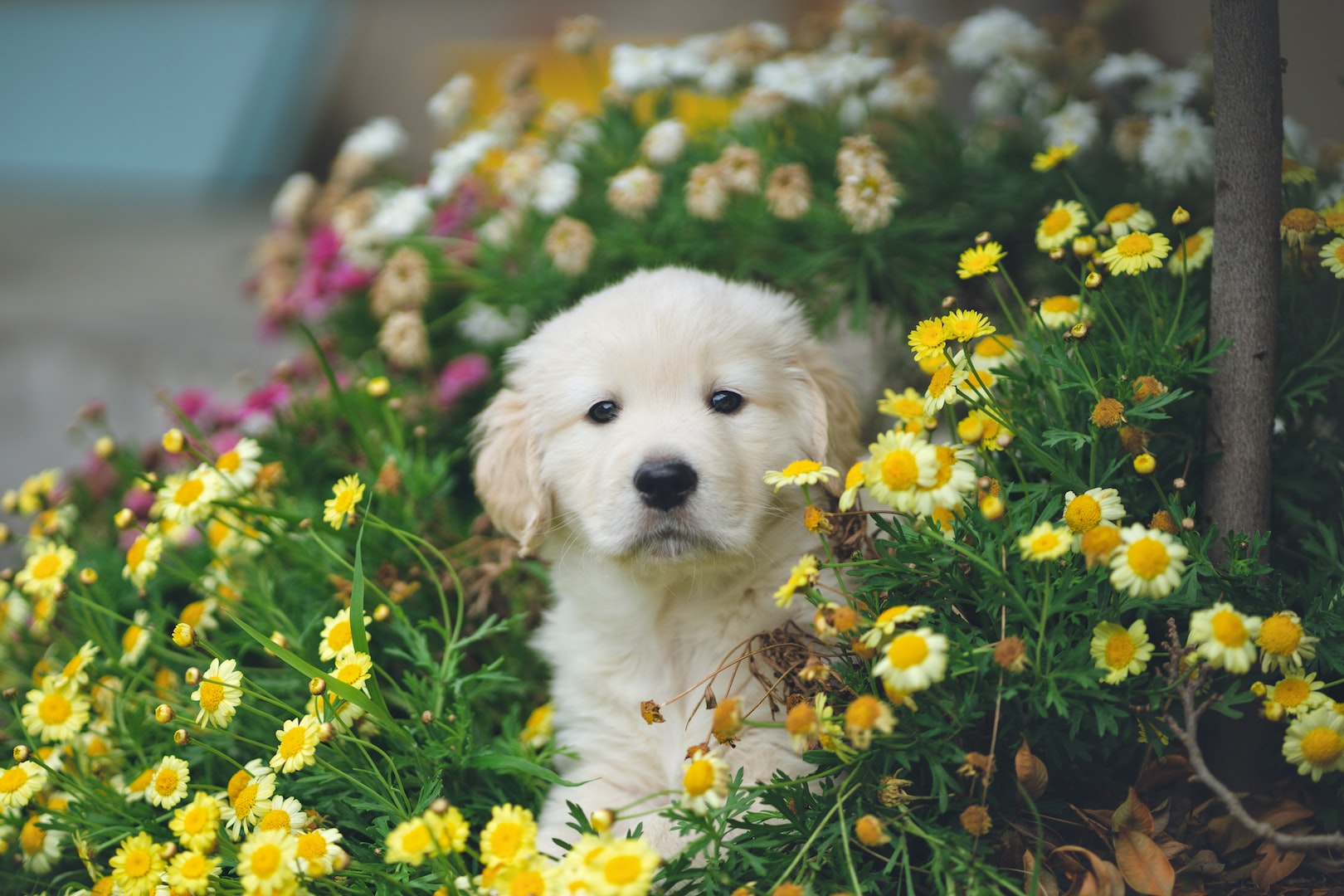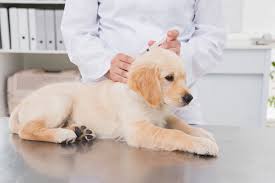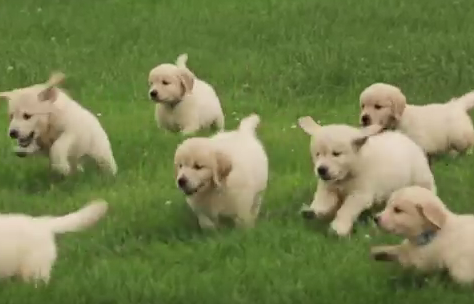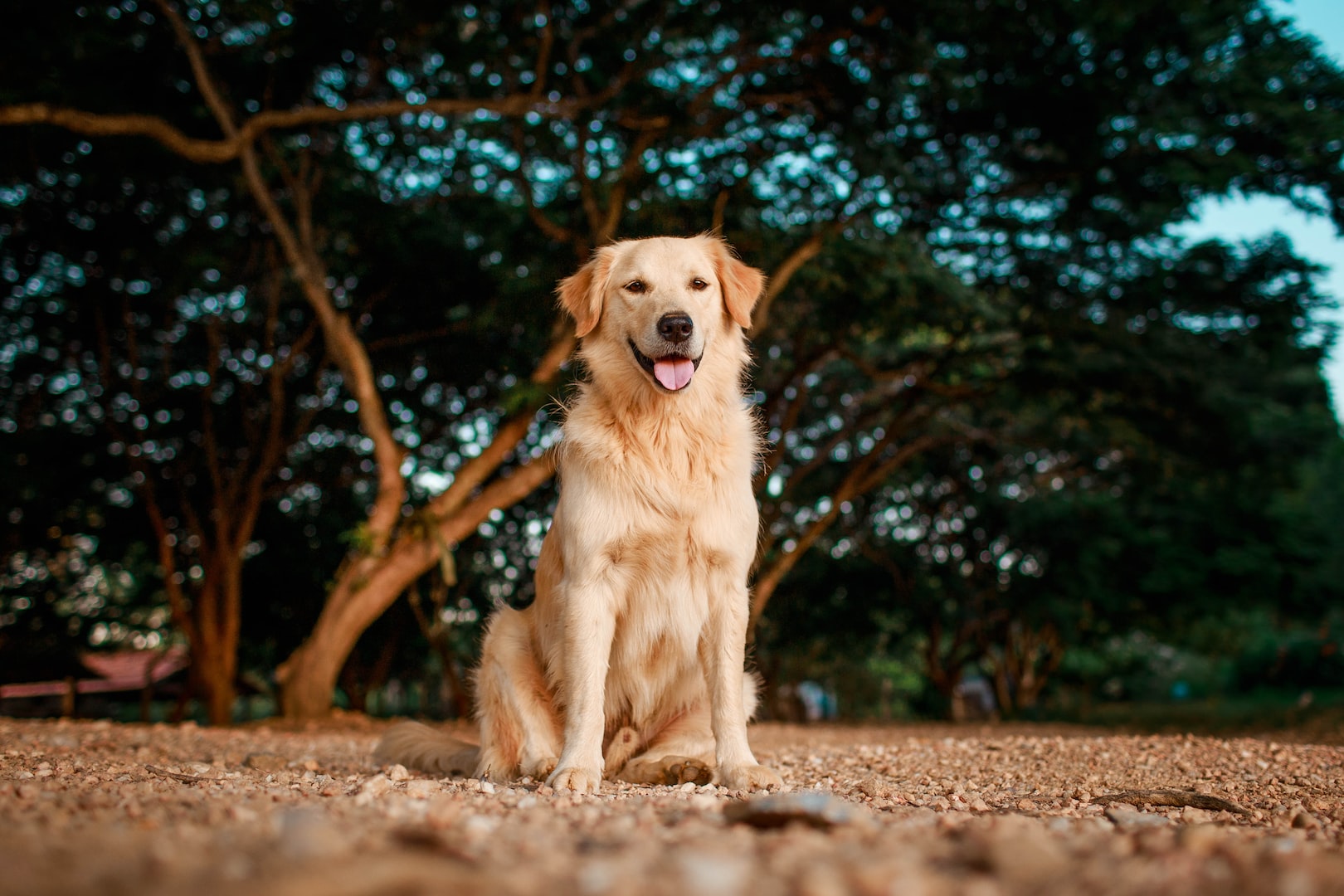
Your Golden Retriever Puppy : Getting Off To A Great Start
Bringing home your Golden Retriever puppy is such an exciting moment. We’re here to help with expert advice on feeding Golden Retriever puppies, potty training, and much more.

If you have just collected your Golden puppy then over the next few weeks you’ll be socializing, potty training and making a start with puppy obedience training.
Many puppy parents have full time jobs and we will also be looking at raising a golden retriever puppy while you work.
Socialising your Golden Retriever Puppy
Every new puppy owner will hear about the importance of puppy socialization. But not all puppy owners carry out this important process effectively.
Socialization means introducing your puppy to many new experiences before they reach the age when they become shy of strangers and strange objects. That age is surprisingly young and most dogs need to be socialized fully before they are 13 weeks old.
That means you need to get going right away with your new Goldie pup!
Your puppy needs to meet lots of different men and women, in different situations, children, other dogs, trains and lorries, and much much more. All from the safety of your arms.
And all before he or she is four months old
Puppy socialization is vital because it helps to prevent dogs becoming aggressive and increases the retention rate of puppies in their homes.
You can find an excellent puppy socialization plan and lots of useful information on
The Puppy Plan website provided by the Kennel Club in association with international charity The Dog’s Trust

Potty training your Golden Retriever puppy
At eight weeks old, your Golden puppy will just pee whenever their little bladder is full. No matter where they happen to be.
So it’s important to think about how you are going to protect any carpeted areas in your home for the first few weeks.
TIP: Baby gates help keep small puppies in areas with washable floors
By eight months things will be very different. Your puppy will be able to last several hours without emptying their bladder, and will have learn to use the appropriate areas for bathroom purposes
The tricky part is getting there, and you may need a little help and support.
The aim in the first couple of weeks is to make sure you take your puppy outside at frequent intervals and wait outside with them until they empty their bladder.
Make sure you take them out after meals and when they wake up from a nap, and whenever they are getting excited – playing with another dog for example.
When your puppy is indoors you need to supervise closely. If you need to leave the puppy for a few minutes, pop them into a small crate as puppies will try hard not to wet in their own bed.
Stopping your puppy from biting
All puppies bite. Even Golden Retrievers! Biting is linked to teething, but it’s also an important part of play between puppies and other dogs.
Biting down on fur isn’t too painful. But biting on skin really hurts and puppies have to learn not to do this.
Play biting is commonly mistaken for aggression because puppies snap and growl when they are playing. For this reason, biting is by far and away the most common reason for new puppy parents to seek help.
Our complete guide to stopping puppies biting will help you quicky through this phase in your puppy’s development
Puppy vaccinations and health care
Most of us have our puppies vaccinated. Vaccines are not completely without risk, but the risk of serious disease for unvaccinated puppies is usually considered by experts to be much greater.
Most puppy parents want to know which vaccinations their puppies need, when their puppies can go outside safely, a few want to know what happens if they decide not to vaccinate their puppies

When Can Puppies Go Outside – The Medical Point of View
Puppies are typically ready to go to their new home at 8 weeks of age. However, just because they’re ready for a new home, doesn’t mean they’re ready for everything else.
Just like human babies, young puppies need a lot of sleep.
According to the Veterinary Medical Association, puppies under three months old can sleep up to 20 hours a day—which doesn’t leave much time for other activities.
As important as socialization is, ensuring your puppy sleeps enough is necessary to ensure proper growth and brain development and will also make sure your puppy is in a good mood.
On top of this, young puppies don’t need as much exercise as older puppies or adult dogs.
A common rule of thumb is five minutes of exercise per month of age. At two months old, this means only ten minutes.
When Can I Take My Puppy For a Walk?
Walking a puppy longer than what they’re ready for can quickly turn into a negative experience—and may even be physically harmful to your puppy.
The growth plates in the long bones of a maturing puppy don’t fully close until a dog is about one year old.
So over-exercising your puppy can be harmful to the development of their skeletal structure.
However, the main reason to be cautious when taking a young puppy outside is exposure to diseases your pup may not be vaccinated against yet.
Risking exposure to diseases your dog is not protected against is dangerous.
Many diseases, such as the parvovirus, can be spread just through contact with inanimate objects.
This means that even sniffing something an infected dog had been in contact with hours previous can potentially infect an unvaccinated puppy.
It’s impossible to know if every dog is up to date on their vaccinations when visiting a park or pet store, so prohibiting contact with strange dogs is extremely important for young puppies.
Even seemingly healthy dogs may carry viruses. This means they may look and act healthy but still have the disease and can spread it to other dogs.
Young puppies don’t have fully developed immune systems, and thus are especially susceptible to illnesses.
That’s why it’s important to never put your puppy on the ground in an unknown environment unless they’ve had all their vaccinations.

When Can Puppies Go Outside in the Garden?
Does waiting to go to the park mean that puppies can’t go outside at all until they’re fully vaccinated?
Thankfully, no! Places such as private gardens and backyards offer safe places for young puppies to explore on their own without running the risk of exposure to dangerous viruses.
A puppy can begin exploring your garden the day you bring them home.
Becoming familiar with your backyard or garden will be a necessary part of potty training.
Here, a young puppy doesn’t run the risk of contracting an illness spread by an unvaccinated dog.
Taking your puppy out for a walk should be delayed until they are fully covered by all their vaccines.
There’s always the chance that an unvaccinated dog sniffed the same section of grass your puppy will want to roll in.
This seemingly small action can result in your puppy coming into contact with a dangerous virus.
As mentioned previously though, your young puppy doesn’t need much exercise.
Most veterinarians agree, puppies are fully vaccinated by 16 weeks of age, which is when they can exercise for about 20 minutes at a time.
Up to this point, the exercise needs of your puppy can be met with within the safety of your home or backyard.
When Can My Puppy Go Outside – The Social Point of View
Keeping your puppy safe doesn’t mean he or she can’t start socializing right away.
If you’re going to meet Dr. Ian Dunbar’s suggestion of one hundred people by the time your puppy is 16 weeks old, your puppy will need to be meeting twelve people a week.
Unless you’re throwing parties every week, it will be hard to meet this goal without your puppy leaving the house.
Pet-friendly stores offer excellent opportunities for your puppy to meet more people. And it’s less likely your puppy will come into direct contact with another dog at these locations.
But it still isn’t safe to put your puppy on the ground if there is any chance of coming into contact with another dog.
Parvovirus can remain alive for up to one year in a non-living environment, so even if you don’t see another dog, it’s still safer to carry your puppy.
As your puppy builds up immunity through vaccines and natural exposure, talk to your vet about safe places you can start letting your puppy explore as they age.
When Can I Put My Puppy on the Ground?
I’ve heard many vets suggest the chances of contracting illnesses on the floor at a veterinary office are slim.
That’s because it is highly unlikely an unvaccinated dog has been there recently. So this can be a great place to sniff around and meet people who love dogs!
Always double check with your vet, though.
The chance of contracting a virus preventable by a vaccine is low at a veterinary clinic, but your veterinarian will be able to tell you for sure if the area is safe or not.
Even if your veterinarian suggests you hold your puppy rather than put him or her on the ground, it’s still a great place to meet new humans.
When I worked at a veterinary clinic, the best part of my day was always meeting a new puppy.
I’m sure the receptionists, vet techs, and anyone else working at the clinic will be ecstatic about cuddling your young puppy while you fill out paperwork!
Vaccination schedules can take up to four visits for a young puppy making your veterinarian’s office a staple in your puppy’s social life.
When Can My Puppy Meet New People?
It’s important to ensure your puppy experiences different types of people.
Children of all ages, tall people, people with hats and sunglasses, people in uniforms, and people with disabilities should all be your puppy’s list of people to meet during socialization.
We’ve all heard stories of dogs who just don’t like men, or people with short hair, or dogs who are afraid of wheelchairs.
Early socialization is the best chance of making sure your puppy doesn’t develop these fears.
Dog-friendly hardware stores make an excellent destination for a young puppy.
Though your puppy shouldn’t explore the floor here, many stores are okay with a puppy being pushed around in the shopping trolly as you walk through the isles.
This saves you from carrying a growing puppy the whole trip and means they get used to the motion of the trolly. Just remember to sanitize the trolly before and after use!
Where Can My Puppy Meet Other Dogs?
Places a young puppy can safely explore on the ground are fairly limited for the first 16 weeks.
One option is to arrange puppy play dates with dogs you may know. It’s important to know not only the vaccination status of a potential playmate but also the temperament of the dog.
Some older dogs aren’t as patient with puppies, which can be dangerous.
If possible, it’s a good idea for your young puppy to meet puppies of a similar age who will be just as excited to play as they are.
This will help teach behavioral cues for future experiences with other dogs and also helps burn some of that puppy energy.
Socialising puppies with humans and other dogs is imperative for every dog, but especially breeds that are prone to aggression.
Dogs bred to have to guard behaviors can become aggressive if they aren’t properly socialized at a young age.
Making sure your puppy not only has a lot of new experiences but positive experiences are ultra important.
Bringing treats along can help to get a distracted puppy’s attention and also boost confidence.
Until your puppy is covered by all vaccines, playgroups should meet in backyards or homes that haven’t come into contact with any unvaccinated dogs.
When Can Puppies Go Outside To Play With Other Dogs?
Finding safe playgroups with other vaccinated dogs is a great way for your puppy to learn how to play.
These playgroups can take place in the safety of a backyard or garden where all the dogs are kept safe from potential environmental exposures and can be monitored closely.
Playgroups are safer than meeting other dogs on walks for another reason.
Leashed dogs are more likely to exhibit fear or anxiety-based aggression, so skipping the park and opting for backyard fun keeps all parties safer.
This means your puppy is set up for success since the experience is more likely to be a positive one.
Balancing the physical health of your puppy along with their behavioral needs doesn’t have to be confusing or complex.
Remembering to take new experiences slow with a new puppy can ensure new experiences are positive.

This means avoiding medical dangers such as exposure to viruses and won’t overwhelm your puppy.
When Can My Puppy Go For a Walk?
It’s tempting to take a new puppy everywhere you can when they first come home.
But ensuring early experiences are positive and safe is the most important part of socialization.
For several weeks, this may mean limiting their exposure to other dogs.
Provided the experiences your puppy does have with other dogs are all primarily positive, though, they should begin to develop social skills at a young age.
Though the critical period for socialization is often quoted as being the first four months, this is simply a foundation.
Continuing to build on these experiences will make for a happy, well-adjusted adult dog.
So When Can My Puppy Go Outside?
The answer isn’t necessarily black and white.
When can puppies go out in a backyard? Right away, provided no unvaccinated dogs have come in contact with the environment beforehand.
However, puppies should wait to explore environments outside the home where other dogs frequent.
Unless you know the vaccine status of every dog that has been in a certain location before you and your puppy, it’s important to not put your puppy on the ground until all vaccines take full effect.
For most puppies, this will be around 16 weeks.
This doesn’t mean that socialization has to be put on hold.
Carrying your puppy or placing them in a sanitized shopping trolly are two great ways of keeping your puppy safe while outside.
From the safety of your arms or another elevated environment, a puppy can still meet a number of new people and experience the world outside your home.
All without running the risk of coming into contact with diseases they aren’t immune against yet.
Raising a Golden puppy while working
We all lead busy lives. And most of us don’t have the luxury of being at home all day.
One of the most common questions we are asked is “how long can I leave my dog alone”.
Many new puppy parents take time off work when they bring their puppy home. But isn’t uncommon for people to think it’s okay to simply leave their puppy alone in the house all day when they return to work.
This is rarely successful. Young dogs left alone for long periods tend to get up to mischief and some become extremely distressed, extremely destructive, or both.
And you cannot successfully house train a puppy if there is no-one there to let the puppy outside
Raising a puppy while you work full time is possible, but it takes planning and thought.
You can’t leave a puppy shut in a crate all day so you’ll have to get help in the form of a doggy day care placement, or a professional dog walker, or a friend or relative willing to babysit your puppy for a few hours each day
Where to get a Golden Retriever puppy
It’s a good idea to buy a puppy from a reputable breeder. This helps to avoid lack of health test certificates, poorly puppies, and other disappointments.
Home bred puppies can be very nice if the owners have taken the trouble to health test and raise their puppies responsibly. Whatever you do, avoid puppy mills and pet stores.
A responsibly bred Golden Retriever puppy will usually cost you around £3000 - £4000
Don’t forget that the cost of sale is just the beginning. Your biggest expense is likely to be annual pet health insurance. It’s a good idea to get some quotes in for this – it will be several hundred £'s a year.
Male Golden Retriever puppies
If you haven’t chosen your puppy yet, you may be undecided between a male and a female. There are a few differences in their needs and care, but not as many as you might think
In some breeds there are greater tendencies to aggression in males compared with females. And people do worry that a male dog might be more likely to fight or bite. However, Golden Retrievers are among the breeds least likely to show aggression to other people or dogs.
We have not seen any evidence that male Goldens are any less likely to be good tempered than females.

And it’s reasonable to assume that your male Goldie is likely to be as friendly and affectionate as his sisters.
Female Golden Retriever puppies
Female Golden Retrievers need a little more care than males unless and until they are spayed. That’s because female dogs come into heat every six months. And need careful protection from males to ensure that they don’t become pregnant.
Neutering was once thought to be the easy solution but has now been linked with a number of different types of cancer and with joint problems, in this breed. So it isn’t a straightforward issue
If you don’t have your female golden spayed, you’ll need to keep a close eye on her for a few weeks after the end of each season as infections of the womb are common at this time.
Should you decide that you want to have your dog neutered, then you’ll find that neutering a female is a more expensive procedure with a longer recovery time than neutering a male.
Are Golden Retriever puppies good family pets?
At times, when your puppy is small, you may question whether or not you have made a mistake in bringing a Golden Retriever into your home. There is a period of adjustment, often known as the ‘puppy blues’ when raising a puppy can all seem a bit much.
Rest assured that Golden Retriever puppies do grow up into great family dogs. They have one of the best temperaments of any dog breed and are ideally suited to a young and active family
There are situations where it might be better to wait before buying a Golden puppy. If you have very tiny kids – remember that Goldens are fairly large dogs and are very boisterous when young. Picking up a toddler and drying their tears for the tenth time before breakfast can become wearing.
Think about the exercise needs of an active dog. If you can’t walk very far, this probably isn’t the breed for you.
If you have a very small home, or live in an apartment, think carefully before adding a big (and potentially muddy) dog to the mix.